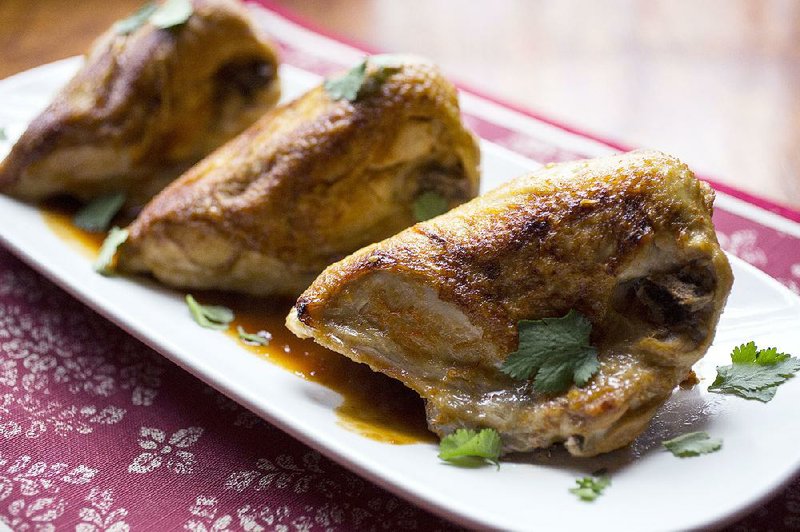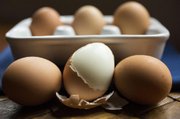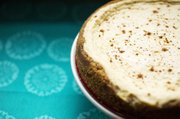I'll be honest. It has taken me several (OK, six) years to really make friends with my pressure cooker.
There are many reasons for my reluctance.
You could blame it on the misguided notion that pressure cookers can be used only for wet, soupy dishes like beans and pot roast.
Or the cooker's reputation for being dangerous. This may have been the case 50 years ago, but today's pressure cookers are no more dangerous than regular cooking pots.
But mostly I've resisted because I'm a sensory cook -- a sniffer, stirrer, peeker, listener and, sometimes, a poker. None of these things are allowed when using a pressure cooker.
The first two have proved to be unfounded. The third, well, I'm still struggling to suppress those urges.
All of the following recipes and techniques were tested using a 2009 model Kuhn Rikon Ecomatic stove-top pressure cooker.
Now that I've experienced the ease of peeling hard-cooked eggs steamed in the pressure cooker, I doubt I'll ever go back to the old way. This method works even with very fresh, farmers market eggs.
Pressure Cooked Eggs
Place a steamer basket in the pressure cooker. Add enough cold water to the pressure cooker to fill it so that the water comes just below the steamer basket -- or the minimum required by the manufacturer. Add as many eggs as will fit in the steamer basket. Close lid and bring to high pressure over high heat. Reduce heat to maintain pressure and cook 3 minutes. Remove from heat and let pressure release naturally for 5 minutes. After 5 minutes if all of the pressure is not released, release pressure following the "normal pressure reduction" instructions with your pressure cooker -- on my cooker this means using the back of a long-handled spoon to depress the pressure indicator until no more steam escapes. Remove lid, being careful to open it away from your face. Transfer eggs to a bowl of ice water. When cool enough to handle, peel and use as desired.
Method adapted from Hip Pressure Cooking by Laura D.A. Pazzaglia
Pressure cookers have long been heralded for their ability to cook beans quickly. But I found beans to be the trickiest thing to get just right in the pressure cooker. My first batch didn't cook long enough, resulting in beans that had hard centers. I cooked the next batch too long and they turned to mush. So unless I'm in a dire hurry and have no canned beans in my pantry, I will likely stick to the traditional simmer for hours method of cooking dried beans.
And yes, it is true you can cook unsoaked dried beans in a pressure cooker, but I had better results when I soaked the beans for at least 6 hours.
Basic Beans
1 pound (2 cups) dried beans, picked over and soaked 6 to 12 hours
1 bay leaf
2 cloves garlic, smashed
1/2 onion, diced
1 tablespoon vegetable oil OR lard OR 1 slice bacon, chopped
Rinse the soaked beans and place them in a 6-quart or larger pressure cooker. Add 4 cups cold water, the bay leaf, garlic, onion and fat.
Lock lid onto pot.
Bring cooker to high pressure over high heat. Once pressure is achieved, reduce heat as much as possible while still maintaining pressure and cook for 5 to 20 minutes depending on type of bean (black beans will take about 5 minutes in a stove-top cooker or 7 minutes in an electric cooker; Great Northern beans will take about 6 minutes in stove-top cooker or 8 minutes in an electric cooker; pinto and kidney beans take about 8 minutes in a stove-top cooker or 10 minutes in an electric cooker; chickpeas take about 13 minutes in a stove-top cooker or 20 minutes in an electric cooker).
Remove from heat and let pressure return to normal naturally.
Makes about 5 cups beans.
Recipe adapted from Hip Pressure Cooking by Laura D.A. Pazzaglia
Sure, it's quicker and easier to open can of Manwich and stir it into browned ground meat, but flavorwise it's hard to beat this pressure cooker version. I particularly enjoyed the saucy meat atop cornbread waffles, but it was equally delicious on hamburger buns.
While you likely won't taste the oats in this recipe, they do add a boost of fiber and bit of texture to the dish. But most of all, they aid in helping keep the meat from tasting greasy.
Sloppy Joes
2 tablespoons vegetable oil
1 onion, finely chopped
1 bell pepper, finely chopped
1 chile pepper such as Fresno or jalapeno, seeded and minced
2 teaspoons minced garlic
2 pounds lean (85 percent or leaner) ground beef OR ground turkey
1 (28-ounce) can crushed tomatoes
1/2 cup rolled oats
3 tablespoons packed brown sugar
2 tablespoons coarse-grain mustard (see note)
2 tablespoons Worcestershire sauce
2 tablespoons apple cider vinegar
1 tablespoon sweet paprika
1 tablespoons smoked paprika
1/4 teaspoon ground cloves
Salt and ground black pepper
Heat the oil in a stove-top pressure cooker set over medium heat or in an electric pressure cooker using its browning function. Add the onion and peppers and saute, stirring often, until vegetables begin to soften. Stir in the garlic and cook 1 minute. Crumble in the ground beef and cook, stirring frequently, until beef is no longer pink. Stir in the tomatoes, oats, brown sugar, mustard, Worcestershire sauce, vinegar, paprikas and cloves.
Lock the lid onto the pot.
Bring to high pressure and cook 5 minutes for a stove-top cooker, reducing the heat as much as possible while maintaining pressure. OR cook at high pressure for 8 minutes using an electric cooker. Remove from heat and let pressure return to normal using the normal pressure reduction (use the back of a long-handled spoon to depress the pressure indicator until no more steam escapes). Season to taste with salt and pepper.
Makes 8 to 10 servings.
Note: I used a combination of stone-ground and fire-roasted chipotle mustard.
Recipe adapted from The Great Big Pressure Cooker Book by Bruce Weinstein and Mark Scarbrough
Sweet-Spicy-Salty Chicken
1/4 cup chicken broth
6 cloves garlic, peeled
3 tablespoons packed brown sugar
3 tablespoons soy sauce
2 tablespoons rice vinegar
1 tablespoon minced fresh ginger or ginger paste
1 tablespoon sambal oelek or other thick Asian chile sauce
2 tablespoons peanut oil
3 pounds skin-on, bone-in chicken pieces
In a blender or food processor, puree the chicken broth, garlic, brown sugar, soy sauce, vinegar, ginger and sambal oelek until smooth; set aside.
Heat the peanut oil in a 6-quart stove-top pressure cooker set over medium heat or in an electric cooker using its browning function. Working in batches, brown chicken on all sides. Pour sauce over chicken. Lock lid on pot. Increase heat to high to bring the cooker to high pressure. Once pressure has been reached, reduce heat as much as possible while maintaining pressure, and cook 12 minutes. Remove from heat and let the pressure return to normal naturally.
To serve, remove chicken pieces to a serving platter. Bring the sauce to a boil and cook, stirring frequently, until sauce has thickened and is reduced by about half. Pour sauce over chicken and serve.
Makes 4 to 6 servings.
Recipe adapted from The Great Big Pressure Cooker Book by Bruce Weinstein and Mark Scarbrough
Maple Cinnamon Cheesecake
1 1/4 cups graham cracker crumbs
1/4 teaspoon ground cinnamon, plus more for dusting
2 tablespoons granulated sugar
5 tablespoons butter
1 (8-ounce) package cream cheese
1 (8-ounce) package Neufchatel cream cheese
1/2 cup maple syrup
1 egg PLUS 2 egg yolks, at room temperature
2 tablespoons all-purpose flour
1 teaspoon vanilla extract
1/4 teaspoon salt
Place a metal rack or trivet in the bottom of a 6-quart pressure cooker. Add 2 cups water.
In a bowl, combine the graham cracker crumbs, cinnamon, sugar and butter and mix until crumbs are uniformly moistened. Press mixture into the bottom and halfway up the sides of a deep 7-inch pan with a removable bottom or a high-sided 2-quart souffle dish; set aside.
In a food processor, or with an electric mixer, beat cream cheeses and maple syrup until smooth. Add the egg and yolks, one at a time, beating well between each addition. Scrape sides of bowl or canister as necessary. Add the flour, vanilla and salt and beat or process until mixture is completely smooth and creamy. Pour over graham cracker crust.
Using two 24-inch pieces of heavy-duty aluminum foil, create a sling for the cheesecake. Fold each sheet of foil in half lengthwise, then fold each strip in half again. You should have two long strips of 3- to 4-inch-wide foil. Lay the strips on a work surface to create an X. Place the pan in the center of the X and fold the ends of the foil over and crimp to create loop handles. Carefully lower pan into pressure cooker.
Lock lid onto pot. Bring a stove top cooker to low pressure and cook, reducing heat as low as possible while still maintaining pressure, and cook 35 minutes. If using an electric cooker, cook on high pressure for 25 minutes.
Let pressure return to normal naturally, about 15 minutes. Remove lid. Use the sling to carefully transfer the baking dish to a wire cooling rack. Cool at room temperature for 1 hour. If using a souffle dish, refrigerate for 3 hours before unmolding, then refrigerate for 6 more hours before serving. If using a pan with a removable bottom, remove from pan after 1 hour, then refrigerate for 6 hours before serving. Dust cake with cinnamon before slicing.
Makes 10 to 12 servings.
Recipe adapted from The Great Big Pressure Cooker Book by Bruce Weinstein and Mark Scarbrough
Food on 03/11/2015



